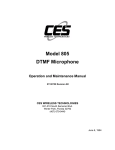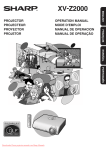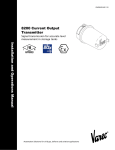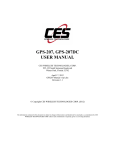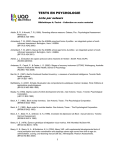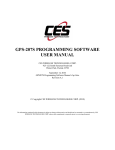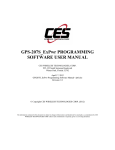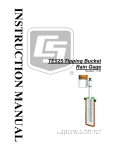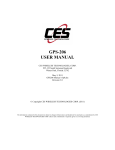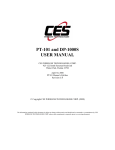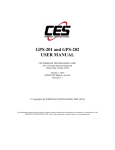Download CES 710 DTMF Specifications
Transcript
Model 710 DTMF Programmable Microphone Manual CES Wireless Technologies 925-122 South Semoran Blvd. Winter Park, FL 32792 Tel 407.679.9440 Fax 407.679.8110 Email: [email protected] Web: www.ceswireless.com 06000561 REV F MAN08A REV 8/02 © CES Wireless Technologies Corp 1991-2002 Page 1 Warranty CES Wireless Technologies Corp., (CES), warrants this product to be free from defects in material and workmanship for one year from the date of shipment. If such malfunction occurs, it will be repaired or replaced (at our option) without charge for materials or labor if returned to the factory. This warranty does not apply to parts damaged due to improper use- including accident, neglect, unreasonable use, and improper installation - or to unauthorized alterations or modifications of the equipment. It does not extend to damage incurred by natural causes such as lightening, fire, floods, or other such catastrophes, nor to damage caused by environmental extremes, such as power surges and or transients. It does not extend to microprocessors if is determined that the failure of a micro is due to static damage, application of improper voltages to the unit, or other problems not related to circuit design. In such case or in the case of a desire to update the micro to a different version of software, such request must be specified in writing, and there will be a charge agreed upon by both parties. This product is warranted to meet published specifications and to operation as specified only when properly installed in radio equipment which complies with US FCC specification and the applicable radio manufacturer’s specifications. CES WIRELESS is not responsible for any operational problems caused by system design, outside interference, or improper installation. A qualified two-way radio technician or engineer must complete installation and programming of this CES WIRELESS product. Equipment for repair must be returned to the factory, freight prepaid, only with prior authorization. Please call 407-679-9440 for an RMA number. A brief letter describing the nature of the defect should be included with the merchandise. Repair by other than CES WIRELESS will void this warranty. In-warranty merchandise must be shipped, freight prepaid, to CES WIRELESS. CES WIRELESS will return the repaired or replaced equipment prepaid to purchaser, within the United States. Outside the US the customer must pay freight. This warranty applies to the original purchaser of the equipment only. CES WIRELESS is not liable under this warranty, or any implied warranty, for loss of use or for other consequential loss or damage experienced by the purchaser. Some states do not permit the exclusion or limitation of implied warranties or consequential damages. This warranty provides special legal rights, and the purchaser may have other rights that vary from state to state. Copyright The information in this manual and any software in this product remain the property of CES WIRELESS. Duplication or disclosure is not permitted without the prior written consent of CES WIRELESS. CES WIRELESS reserves the right to change products, specifications, and installation data at any time, without notice. All information contained in this document is carefully prepared and offered in good faith as a guide in the installation, operation, use and servicing of our products. Installers must insure that the final installation operates satisfactory, within relevant regulatory requirements. We accept no responsibility for incorrect installations. CES WIRELESS PUBLICATION Copyright CES WIRELESS 1991-2002 Page 2 Model 710 Manual GENERAL DESCRIPTION The CES Model 710 DTMF Encoder Microphone is engineered specifically for mobile radio applications. Whether used on SMR trunked systems, conventional telephone interconnected shared mobile radio systems, or in dedicated single-user radio systems, your new 710 series microphone will enhance the utility of your mobile communications. It's automatic ANI (Automatic Number Identification) and automatic-dialing features will be a great convenience to you when using your mobile radio system and while operating a motor vehicle. Standard features in the Model 710 microphone include: Automatic push-to-talk transmitter keying Level matching to interface with any transceiver "Store and send" of manually dialed numbers Automatic "off-hook" and "on-hook" ANI's Automatic dialing of up to 21 digit numbers Durable back lighted silicone rubber keypad Precise crystal controlled tone generation Autodialing of "4th column" tones (A, B, C, D) Automatic microphone muting Audible DTMF sidetone Auto-encode of two different 21 digit ANI's Auto-dial and auto-ANI speed changes and delays Auto-dial pauses, with or without PTT Rugged urethane extreme temperature coil cord Ten year non-volatile EEPROM memory (no battery backup required) Page 3 INSTALLATION Your CES Model 710 DTMF Encoder microphone requires filtered +10 to +15 VDC to power it's audible sidetone, keypad illumination, and microprocessor. The 710 is available with factory installed mating connectors for many popular transceivers. The connectors are configured to receive the required operating power at the radio microphone jack. Some transceivers may not already have a provided voltage source output available at the microphone jack. In this case, a minor modification will be necessary and can be accomplished by a two-way radio technician. Locate a switched and filtered source of +10 to +15 VDC within the radio and connect it to an unused terminal on the microphone jack. If you are using a microphone with a factory-installed connector: use the terminal associated with the microphone Blue wire. In the case where no spare or unused connection is available, determine an appropriate function that is otherwise not going to be used, such as "handset audio", or other. It is important to utilize a filtered voltage source for the microphone operation. If alternator whine or other ignition noise is experienced on the transmitted audio, another voltage source should be located and used. In severe cases, a filter available from an appropriate supplier should eliminate the problem. If your microphone was ordered without an installed connector, then install a connector on the Model 710 microphone cord as follows: Cable Wire Color Function BLUE + 12 VDC RED Push-To-Talk (logic low) WHITE TX Audio Output BLACK CTCSS Hang Up (logic low) SHIELD Audio/Analog Ground YELLOW Power & Logic Ground Jumper JP2 - Microphone Low/Power Ground Isolation Jumper Jumper JP2 is used to isolate the microphone low in the microphone from the logic and power ground. If the voltage supplied to the microphone is not well filtered (or if noise is experienced on transmit), or for transceivers that require separate ground returns, remove (cut) jumper JP2. CTCSS Hang Up is a logical function that will normally provide an off-hook (open-circuit) or on-hook (closedcircuit) to the radio for CTCSS "monitor", or other applications. This requires a grounded hang-up clip for the microphone. For applications where an open circuit is required for an on-hook condition (off-hook=closed circuit), a logic inverter option is available. Page 4 LEVEL SETTING AND INTERFACE ADJUSTMENTS Jumper JP1 - Audio Gain Select Jumper This jumper is used to set the range of microphone and DTMF audio output from the 710 microphone. The 710 is shipped with JP1 installed (IN), and will accommodate requirements where the microphone audio is in the range of 40 mV or less. For transceivers that require a higher level microphone input, cut JP1 (OUT) as shown in Figure "A". Audio Output Level (RV2) This adjustment sets the microphone level for voice modulation only. While monitoring the transmitter frequency on a service monitor, press the microphone PTT switch and set RV2 on the 710 microphone so that the voice deviation just goes into limiting (clipping) while speaking in just above an above-average level. DTMF Tone Output Level (RV1) For reliable DTMF signaling: The DTMF tone deviation should be approximately 2/3 of the maximum deviation (for example: if the modulation limiting is set to 5.0 KHz, then the DTMF level should be 3.3 KHz). In any event, the DTMF Tone transmitted by the 710 microphone should not be clipped or distorted. If your service monitor does not have a CRT display to observe the transmitted waveform, use an oscilloscope connected to the "demod" output from the service monitor to visually verify the quality of this signal. Set RV1 for the proper DTMF Tone level (3.3 KHz). Note: Since no ANI's are programmed in the Model 710 microphone when you receive it from the factory, the "*" and "#" keys can be used to manually generate a DTMF tone for level setting. Automatic Off-Hook ANI-UP and On-Hook ANI-DOWN This feature is not enabled as shipped from the factory. To enable the feature: solder a jumper wire across JP3, placing CR2 into the circuit (see schematic diagram). The feature has applications in some radio common carrier and other services. OPERATION PROGRAMMING ANI The Automatic Number Identification and Automatic Dialing features may be programmed by either the system operator/dealer or the user. Because the Automatic ANI feature of the Model 710 is a control feature only applicable to the system owner or dealer, instructions for programming the ANI's are published in a separate instruction manual available only to authorized dealers, service technicians, systems operators, and radio common carriers. Once the ANI's have been programmed, operation of the Model 710 to transmit the ANI's is simple: The "ANI-UP" code is automatically transmitted whenever the "*" key is depressed. Pressing the "#" key sends the "ANI-DOWN" code. These ANI codes can also be sent with the "OFF-Hook" and "ON-Hook" function, if enabled. The actual functions of the ANI codes are system-dependent. With the Model 710 sidetone feature, you can hear the actual ANI codes as they are transmitted. After the transmission of the ANI-UP code is sent, you should wait for a dial tone and then manually or automatically dial the desired telephone number (normal operation). For other system operations: contact your system operator or manager for instructions. Page 5 Manual Dialing Mode Manual dialing consists of pressing one or more of the 12 digits on the keypad to dial that number. This mode operates the same as a regular telephone keypad. When a key is depressed, the microphone will automatically key the transmitter and generate that DTMF digit. When the key is released, the DTMF generation will cease and the microphone will unkey the transmitter after a 2-second delay. If other keys are pressed within 2 seconds, the internal timer will reset and continue to key the transmitter until the 2-second timer expires. The only exception to this is if the "*" key and/or "#" key are programmed with an ANI-UP or ANI-DOWN code. If ANI's are programmed, pressing the "*" or "#" will result in the transmission of the respect ANI code. The PTT switch should not be depressed during any dialing. AutoDial Memory Mode This mode allows the user to press a single key to transmit a number in the autodial memory stored by the user. User programmed numbers may be stored in any autodial location from 1 through 8. After an autodial location key is depressed, the user will hear the autodial number transmitted by the sidetone generator. Up to 21 digit numbers may be stored in any one of the eight memory locations. If an autodial location is selected that does not have a number stored, then only a <beep>tone will be heard. The PTT switch should not be depressed during the memory select or dialing sequence. Keypad numbers 9 and 0 are used for programming autodial numbers, and special manual dialing modes that will be described below. Programming Autodial Memory Begin by entering the "9" key followed by an autodial location 1-8, and then the number desired to store at that location. After the entire sequence is entered, press the microphone PTT switch to store the number at the selected location. Example: To store the telephone number 1-800-327-9956 at memory location 5, press the following keys: "9 5 18003279956 <PTT>" After the PTT switch is pressed a <beep> tone will be heard, confirming that the entry has been written to memory. (If a <beep> tone is heard prior to pressing the PTT switch, this indicates that an incorrect key has been pressed, and the operation has been canceled.) An autodial memory location may be overwritten at any time with a new number. An autodial memory location may be cleared of any number by entering: 9 [location 1-8] <PTT> SPECIAL MANUAL DTMF DIALING MODES In the DTMF Autodialing Mode two different manual DTMF dialing modes are available for use. The first manual DTMF dialing mode is called "Store and Send" Manual Dialing. The second mode is called "Timed Manual Dialing". The "Store and Send" mode is enabled in the Model 710 microphone as received from the factory. "Store and Send" Manual Dialing Page 6 This mode allows the user to manually dial up to a 50 digit number before it is actually transmitted. Using this mode, a telephone number can be accumulated in memory, and then transmitted at a later time. It is accomplished by pressing the "0" key, followed by the telephone number desired. When you are ready to send the number, press the PTT switch briefly to initiate the transmission. This feature may also be used for applications where the ANI-UP code is needed to obtain a system connection, and to dial a commonly used telephone number (Example): "0 * 5551212" Programs the "Store and Send" function with the (pre-programmed) ANI and the desired telephone number (5551212). To use the feature: When ready to proceed with the call, momentarily depress the PTT switch. The microphone will send the ANI-UP code automatically. Once the dial tone is heard, again press the PTT switch momentarily and the telephone number will be sent. To cancel the dialing sequence, press and hold the PTT switch for three seconds and release. A <beep> tone indicates that the "Store and Send" sequence has been cancelled by the user. Timed Manual Dialing The second manual dialing mode is called "Timed Manual Dialing", and allows the user to manually enter up to 12 keypad digits, similar to the Manual Dialing Mode described earlier in the Operation section. In using this mode, the DTMF digits are sent at a fixed length. To enable the Timed Manual Dialing mode, press the "0" key and within 2 seconds, dial the DTMF digits that are to be directly manually dialed. The transmitter will unkey 2 seconds after the last digit is pressed. Note: In order for the Timed or "Store and Send" DTMF dialing to be functional, the microphone must first be placed in the DTMF autodial mode by the dealer. Page 7 PROGRAMMING SPECIAL FUNCTIONS When programming numbers for autodialing or accumulated DTMF manual dialing, the following two-digit functions can be entered as part of the stored number. Entry Code Function #1, #4, #7, #9 A, B, C, or D Tones #2 or #3 FASTER or SLOWER dialing #5 PAUSE or DELAY with PTT ON #6 PAUSE until next key #0 or #8 DELAY 1 or 2 seconds ## # Tone #* * Tone ABCD Tones (Fourth column tones) - are stored by pressing the "#" key and then 1, 4, 7, or 9 to generate the A, B, C, or D tones respectively. To program a fourth column tone under any memory location 1-8, the same method is used in the programming sequence. Example: To program 12C58 under memory location 3: press 9 3 12 #7 58 <PTT> FASTER Dialing #2 - This double entry stores only one digit and results in dialing at double the normal speed. SLOWER Dialing #3 - This double entry stores only one digit and results in dialing at one-half the normal speed. Note: Multiple faster and slower codes may be used in a programmed dialing sequence location. The dialing rate will automatically reset to the original programmed speed after completion of dialing from an autodial memory location. ENABLE PTT - #5 - Whenever the enable PTT code precedes either a pause or delay code, the following pause or delay codes will result with PTT remaining on. This code must be programmed prior to each pause or delay, if continuous PTT is desired. PAUSE #6 - Transmission of the remainder of a stored number sequence will halt until the PTT switch is briefly pressed. To cancel the remainder of a transmission that has been interrupted by a "pause", press the PTT switch for at least 3 seconds and release. A beep tone will indicate the transmission has been canceled. DELAY #0 or #8 - Activates an automatic 1 or 2 second delay with the PTT off, followed by a one second delay with PTT on, and the continuation of the stored number. If the delay is preceded by a #5, the PTT will remain on. POUND ## - Stores one "#" code each time "##" is entered. STAR #* - Stores one "*" code each time "#*" is entered. Example: Program autodial location 5 with an ANI code of "*1234" followed by a "pause", with the PTT unkeyed, Page 8 and then the telephone number "555-1212". Send the ANI code at twice the normal dialing rate, and the telephone number at the normal autodialing rate. Enter: 9 Allow autodialing programming 5 Program autodial location 5 #2 Increase dialing speed X2 #*1234 ANI code #3 Reduce dialing speed by one-half previous (to normal) #6 Unkey TX and pause #5551212 Telephone number <PTT> Store number sequence as entered Page 9 PROGRAMMING SPECIAL FUNCTIONS -continued Summary of Manual Dialing Press any key to generate that DTMF digit. Press "*" or "#" to send ANI-UP or ANI-DOWN, if programmed. Summary of Autodialing To send a pre-programmed number sequence from a memory location, press the applicable key 1-8 to autodial. To store a number in a memory location: press 9 plus the memory location (1-8) plus number, and then press PTT switch to store. Press "*" or "#" to send ANI-UP or ANI-DOWN, if programmed. Summary of "Store and Send" Manual Dialing Press the "0" key and then the number to accumulate in memory. Then press the PTT switch briefly to send the number sequence. Summary of Timed Manual Dialing Press the "0" key and within 2 seconds enter the desired telephone number. The transmitter will unkey 2 seconds after the last digit is sent. Page 10 CES 060005 61 REV F HAN G UP JP5 RN2 1 See Side view for positioning of C7 JP1 + Y1 RN1 1 R18 C7 L1 1 CES Wireless Technologies 925-122 South Semoran Blvd Winter Park, FL 32792 710A COMPONENT LAYOUT (SIDE A) Drawing: CES P/N: Page 11 AP00115A. CNV 060 00561 REV F Date: 04/ 26/02 (updated 07/10/02) Drawn By: T. Rodrigue z 710 DTMF Microphone Parts List Symbol Number C1, 11 C2, 12 C15-17 C3 C4 C5 C6 C7 C8 C9, 10 C14 CR1 CR2,3 CR4 L1 Q1 Q2 Q3,4 R1,18 R3 R4, 6 R5 R7, 9 R8 R10, R21 R11 R12 R13, 17 R14 R15 R16 R20 R21 RV1 RV2 CES Part Number Symbol Number 1uf 35V Tant. Capacitor .1uf 50V Capacitor CT1 CM.1 RN1 RN2 10KΩ Resistor Network 15KΩ R-2R Network 1500 pf Capacitor 3900 pf Capacitor .022 uf Capacitor 470 pf Capacitor 2.2 uf NP Capacitor 10 uf 25V Capacitor 27 pf 100V Capacitor 10 uf 25V Capacitor 24V 1W Zener Diode 5280-2800 Diode 6.8V .5W Zener Diode 10 H 370 mA Inductor NPN Darlington N Channel Mosfet NPN Transistor 4.7KΩ 1/8W Resistor 68 Ω 1/8W Resistor 27KΩ 1/8W Resistor 8.2KΩ 1/8W Resistor 120KΩ 1/8W Resistor 470Ω 1/8W Resistor 470Ω 1/8W Resistor 6.2KΩ 1/8W Resistor 6.8KΩ 1/8W Resistor 10KΩ 1/8W Resistor 10MΩ 1/8W Resistor 330KΩ 1/8W Resistor 47KΩ 1/8W Resistor 100Ω 1/8W Resistor 470Ω 1/8W Resistor 100KΩ Potentiometer 50KΩ Potentiometer CM1501 CM392 CM.022 CM471 CE2.2NP CT10 CM270 CT106 D4749 D103A D5235 CHOKE2 QA13 QVN10 Q2222 RC472 RC680 RC27K RC8.2K RC124 RC332 RC470 RC682 RC682 RC10K RC10M RC334 RC473 RC100 RC471 RV100K RV503A P1 P2 Connector, 6 Pole Flex Strip, 9-circuit SW1 PTT Switch U1 U2 U3 256X8 Serial EEPROM CMOS Microprocessor Dual Jfet Op Amp VR1 5V Regulator TO-92 Y1 3.579 Mhz Crystal NONREF ITEMS Front Case Half Rear Case Half Hang-up Button Ground wire w/terminal Felt Screen Metal Screen PTT Lever, Plastic Rubber Ring Microphone Element Neoprene Pad Case Screw #4 x 5/16" Description EM1 Description Microphone Cord Strain Relief Rubber Boot Complete Case Assembly Rear Label (710A) CES Part Number RSIP5 RSIP1 CON54 FLEX1 MIC01-M U24C04 SMU68hc05 U062 U78L05 XTAL3 MIC01-A MIC01-B MIC01-C MIC01-D MIC01-E MIC01-F MIC01-G MIC01-H MIC01-K PAD03 SCREW40 CRDCES-1 STRNREL0 4 BOOT1 600LMF LABEL001 Page 12












